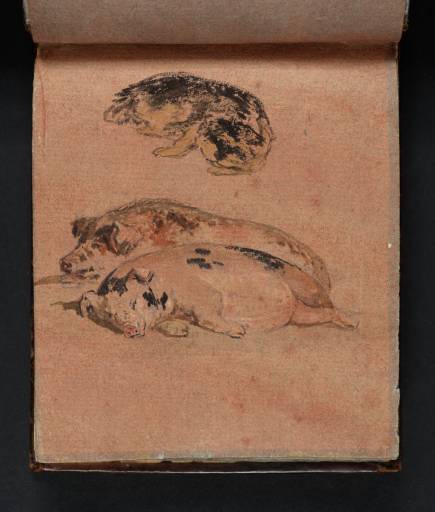Joseph Mallord William Turner Studies of Pigs 1796
Joseph Mallord William Turner,
Studies of Pigs
1796
Joseph Mallord William Turner 1775–1851
Folio 4 Recto:
Studies of Pigs 1796
D00838
Turner Bequest XXX 93
Turner Bequest XXX 93
Pencil, watercolour and gouache on blue laid paper prepared with a red-brown wash, 126 x 108 mm
Stamped in black ‘XXX – 93’ bottom right
Stamped in black ‘XXX – 93’ bottom right
Exhibition history
1904
National Gallery, London, various dates to at least 1904 (565a, as ‘Study of Pigs’).
References
1902
E.T. Cook (ed.), Ruskin on Pictures: A Collection of Criticisms by John Ruskin not heretofore Re-printed and now Re-edited and Re-arranged: Vol.I: Turner at the National Gallery and in Mr. Ruskin’s Collection, London 1902, p.232 no.565.
1904
E.T. Cook and Alexander Wedderburn (eds.), Library Edition: The Works of John Ruskin: Volume XIII: Turner: The Harbours of England; Catalogues and Notes, London 1904, pp.272 no.94, 635 no.565, as ‘Study of Pigs’.
1909
A.J. Finberg, A Complete Inventory of the Drawings of the Turner Bequest, London 1909, vol.I, p.62, XXX 93, as ‘Study of pigs’.
1920
D[ugald] S[utherland] MacColl, National Gallery, Millbank: Catalogue: Turner Collection, London 1920, p.48.
1961
Alexander J. Finberg, The Life of J.M.W. Turner, R.A. Second Edition, Revised, with a Supplement, by Hilda F. Finberg, revised ed., Oxford 1961, p.34.
Technique and condition
This watercolour is in the small-scale Studies near Brighton sketchbook (Tate; Turner Bequest XXX) made from several sheets each of white wove Whatman paper and strong blue laid wrapping paper. This sketchbook was probably bound by William Dickie at 120 Strand, London, who bound many of Turner’s sketchbooks, often using paper supplied by Turner himself (Bower 1994). A similar blue paper is found in the Wilson sketchbook (Tate; Turner Bequest XXXVII). In the Studies near Brighton sketchbook Turner also prepared some of the blue pages with a red wash, while in the Wilson sketchbook every page was so treated, and Turner may have done this himself before the book was bound.1 The Wilson sketchbook would have had deep red-brown pages originally, all of which have lost colour. Its red wash was applied with glue size, probably brushed on hot for ease of application. This sizing and the somewhat unusual presence of wool fibres in the paper in addition to the more common linen ones gave a very strong paper which could survive vigorous brushwork and repeated soaking during the painting process.2
The red wash here was applied with less glue size than in the other sketchbook, and has some colour variation across the pages. Such a red-brown page made a perfect base tone for the two pigs, which could then be represented economically by creating light brown ochre watercolour outlines with a fine brush for their backs and limbs, and adding black markings, deeper pink ones with red ochre, and emphatic brown shadows for their large ears, using small dabs of pure colours.
Though all three animals are dozing, the cat is a less lively and detailed image. It was also outlined in a thin, light brown ochre watercolour wash which then required a rapid infill with yellowish ochre, to give conviction to the tabby markings that were rapidly scratched into opaque dark brown and black washes applied to its back. These techniques did not require the heavily-sized paper of the Wilson sketchbook.
Helen Evans
October 2008
Revised by Joyce Townsend
February 2011
How to cite
Helen Evans, 'Technique and Condition', October 2008, revised by Joyce Townsend, February 2011, in Andrew Wilton, ‘Studies of Pigs 1796 by Joseph Mallord William Turner’, catalogue entry, May 2011, in David Blayney Brown (ed.), J.M.W. Turner: Sketchbooks, Drawings and Watercolours, Tate Research Publication, November 2014, https://wwwTurner made this study with the page turned vertically. See folio 93 recto (D00839; Turner Bequest XXX 94), another study of pigs evidently made at the same time as this.
John Ruskin singled out this sheet for exhibition, with a drawing of donkeys (Tate D22769; Turner Bequest CCXLIV 107). He wrote of the pair: ‘Both wonderful, quite beyond telling. There is an etching of Rembrandt’s which approaches the upper study [i.e. the Pigs] but by no means equals it. Examine it for a quarter of an hour through a magnifying-glass and you will see something of what it is.’1
Technical notes:
The page has faded, except at the edges, owing to prolonged exposure when it was exhibited.
Verso:
Blank, prepared with a red-brown wash; blind-stamped ‘XXX – 93’ above Turner Bequest monogram, inscribed in red ink ‘a’ and inscribed in pencil ‘XXX – 93’.
Andrew Wilton
May 2011
How to cite
Andrew Wilton, ‘Studies of Pigs 1796 by Joseph Mallord William Turner’, catalogue entry, May 2011, in David Blayney Brown (ed.), J.M.W. Turner: Sketchbooks, Drawings and Watercolours, Tate Research Publication, November 2014, https://www

